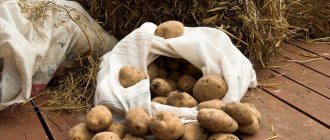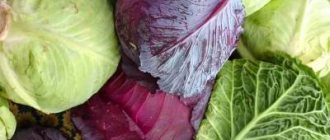It is not for nothing that potatoes bear the honorary name “second bread”. It has firmly entered the menu of every person. It is impossible to imagine soup without it; it perfectly complements meat and fish dishes. It is planted in almost every garden plot. The digging period begins in August and can last until October. The lucky ones are those who own their own houses with spacious cellars and basements. This is where it is most convenient to store the harvested crop. But what about apartment owners? It's simple. Look around your home - there will certainly be a suitable place there. All that remains is to decide on the container and start preparing the tubers.
Features of storing potatoes in an apartment
You can easily place potatoes for storage right in your apartment if you meet a number of necessary requirements. Having collected the harvest from the plot, there is no need to immediately store it in the apartment. It must be properly prepared to extend its shelf life.
Preparation
Any potato needs preparation for storage, whether it is collected with your own hands or purchased at the market. As soon as you deliver the vegetables home, the question immediately arises of how to place them correctly so that the tubers last as long as possible. Most often, a balcony or cellar for residents of the first floors comes to the rescue. Sometimes in high-rise buildings, residents have their own basements, where they can also store crops if these premises are not flooded during the season.
Whatever location you choose, the tubers need to be properly prepared. To do this, you will have to adhere to a number of certain conditions:
- Drying . This procedure is performed immediately after the tubers are removed from the ground. It consists of placing vegetables in the sun for about 2-3 hours so that they dry out and the stuck soil falls off the peel. This helps reduce the risk of rot forming. After this, the potatoes must be left in a dark, well-ventilated place. It is desirable that the humidity in the room is 95% and the air temperature is +12...+18 °C. During this period, damage received from garden tools during the digging process will heal, and resistance to the development of putrefactive diseases will increase. If sprouts begin to appear on the tubers, all of them need to be plucked off.
- Maintaining temperature conditions . Potatoes can easily become rotten if the storage temperature is inappropriate. Scientists have proven that potatoes “breathe” during storage. A specific microenvironment is created between the tubers, in which there is both moisture and carbon dioxide. Potatoes will begin to lose their shape or shrivel if the temperature is too high due to excess evaporation. The taste of such a product will obviously not be the most pleasant. That is why it is believed that potatoes feel best at +3...+7 °C. Experienced gardeners line rows of potatoes with rowan or wormwood leaves, this reduces the likelihood of rot and bacteria appearing. Periodically you need to sort through the crop, removing spoiled and rotting tubers and pinching off the sprouts that have appeared.
- Choosing the right variety . When planting potatoes or purchasing a ready-made crop that will be stored for a long time, pay attention to the variety. Early potatoes will not last long; they need to be eaten almost immediately after digging. Varieties with average ripening periods can be stored for no more than three months. But it is best to choose mid-late and late-ripening varieties. If stored properly, they may well last until spring. Keeping quality will be influenced by the composition of the soil in which the potato “sat”, the conditions for its cultivation, the weather when digging, and even the phase of the Lunar calendar. Experienced gardeners know that with an excess of nitrogenous fertilizers in the garden, the shelf life of potatoes drops significantly.
- Sorting . Before sending the crop for storage, you need to carefully examine it again. If you see tubers with marks from garden tools, they need to be removed; bacteria will quickly begin to multiply in places of damage. But such potatoes can be eaten as food, but on the condition that there are no signs of rot on them and the insides have not turned black. If such potatoes get into the general mass, they can quickly rot and infect all neighbors.
There are no special difficulties or intricacies in storing potatoes at home; just follow a few simple rules, prepare the place, and all winter you can enjoy having delicious potatoes on hand.
Necessary conditions for storing potatoes in an apartment
Of course, today you can buy vegetables all year round. Then there will be no problems with storage either; in any, even the smallest apartment, there will always be somewhere to place a couple of kilograms of potatoes. But lately, crops collected from one’s own garden have become increasingly popular. It tastes better and contains many times more beneficial properties.
That’s when gardeners start thinking about where to store it. The underground is, of course, good. What if he is not there? You can also find a suitable place in the apartment, so don’t be discouraged.
Humidity
An important condition for home storage is maintaining the required level of humidity. The optimal figure is 80-90%. But if, in combination with it, the indoor climate remains too warm, then sprouts will begin to actively appear on the tubers.
How can you achieve the right humidity for your crop?
- Ventilate the potato storage area.
- Provide the required level of air flow.
- Do not store potatoes where there is a lot of evaporation.
- Do not place containers with vegetables close to the wall, as this will cause condensation to form on the tubers.
- To prevent moisture from appearing, the tubers can be lined with dry straw.
- Potatoes are strictly not recommended to be placed next to other vegetables; they are only suitable next to beets.
If the kitchen is chosen as the storage location, make sure that the hood is always running while cooking. Otherwise, the tubers will become covered with condensation and begin to rot or sprout.
Temperature
The most difficult thing in indoor storage is to ensure a comfortable temperature for the potatoes. Naturally, there can be no talk of any +3..+7 °C. But a very useful property of potatoes comes to the aid of gardeners - this is a dormant state in which the tubers can remain from 1 to 3 months after being removed from the garden. Therefore, even the absence of a balcony is not an obstacle to storing crops at home. You can regulate temperature indicators in several ways:
- Never leave the box in direct sunlight. As soon as the tuber turns green due to ultraviolet radiation, dangerous solanine will appear in it, and it will no longer be possible to eat it.
- In every home there is a place where there is no heating. This could be a hallway, storage room or balcony. This is where you need to place the potatoes for storage.
- Avoid freezing of fruits, which occurs already at the onset of the first frost. If vegetables were stored on the balcony, they should be returned to the apartment after it gets cold.
- Do not place potatoes near heating appliances.
- Leave a thermometer inside the container to always know the temperature.
So, despite the fact that potatoes are best stored at a temperature of +2...+7 °C, even at +16...+19 °C in an apartment they can last up to six months. But it is very easy to shorten this period by violating storage conditions, especially with regard to humidity. If you don’t want your entire crop to turn into a rotten mass in a couple of weeks, try to follow the basic recommendations.
If the thermometer on the balcony drops below zero, the risk that the fruits will freeze increases. After thawing, their taste will change dramatically; such potatoes will no longer be suitable for cooking.
Illumination
Before storing potatoes for permanent storage, they must be kept in fresh air for about two hours in dry, sunny weather. Firstly, the fruits will dry well. Secondly, all the earth stuck to it will fly off the peel. After this, the potatoes should lie for some time in a dark, well-ventilated room and only then go into bags.
Do not expose potatoes to direct sunlight, as this will cause the synthesis of a dangerous substance – solanine. In very small quantities it suppresses the activity of pathogenic microorganisms. But if its concentration increases, then the fruits themselves will acquire a greenish tint, and it will no longer be possible to eat them. Therefore, properly cover those vegetables that are stored on the balcony.
Try to maintain the same level of temperature and humidity throughout the potato storage period, this will help reduce the risk of rot and reduce the number of sprouts that appear.
Air access
To increase the shelf life of potatoes, it is necessary to periodically ventilate the room where they are stored. This measure will help regulate the humidity level in the room. Those vegetables that breathe best are those stored in bags, nets or plastic boxes with holes around the perimeter of the walls. If you choose wooden containers, make sure they have holes for air.
It is strictly forbidden to store potatoes in plastic bags and packages. This material does not breathe at all; the tubers very quickly begin to rot and become covered with mold. You can no longer eat such vegetables.
Potato storage container
To ensure that the potatoes last a long time and do not rot or become moldy, you need to choose the right container or container. There are several options for placing potatoes for winter storage:
- A plastic bag is only suitable for short-term storage of potatoes in the refrigerator or for transporting tubers.
- A fabric bag allows air to pass through well, allowing vegetables to breathe in it.
- A mesh made of nylon is inexpensive and provides air circulation between the tubers.
- Plastic containers are easy to use, have holes in the walls and bottom, are available for purchase, and are sometimes displayed in stores for free.
- A wicker basket is well ventilated and prevents mold from growing.
- Cardboard boxes are not the best method, but they will work fine if you line the bottom with newspaper to absorb moisture.
- A wooden box is the most optimal option for storing potatoes; it can be either with gaps for ventilation or with double insulated walls.
Bags and boxes are the most popular means of storing potatoes. A wooden box, if properly treated and disinfected, will last for many years. The bag can also be used for several seasons if used carefully.
Additional bookcase organizers
Purchasing a separate bedside table exclusively for vegetables is the easiest way to solve the problem. It is suitable for those who do not want the hassle of reorganizing and coming up with unique approaches.
It is enough to decide on the installation location of the new furniture attribute and the desired parameters, and then find the necessary item on sale or order it according to individual measurements. Such shelves can be corner or standard. They are made of plastic, wood, metal profiles, metal mesh, etc.
How to save potatoes for planting in an apartment
Not all the potatoes collected are used for food. At the sorting stage, tubers are selected from the entire harvest to be used for cooking in the fall and winter. But some of the collected potatoes must be left for next year in order to plant them in the garden. Especially if the harvest from these bushes impressed you. For these purposes, you need to choose smooth, dense tubers that are not too large in size. Make sure that there are no traces of a shovel or fork on them, otherwise the potato itself will get sick and infect all its neighbors. Experienced gardeners know that temporary exposure of vegetables to the sun will help extend the shelf life. Just a few hours are enough for solanine to begin to be synthesized. In large quantities it is dangerous for the digestive tract, but in small doses it creates natural protection against pathogenic microorganisms.
To select seed potatoes for home storage, you must adhere to the following recommendations:
- Do not try to choose the largest tubers; their size should not be gigantic, otherwise they may not last until planting.
- Do not rush to quickly put seed potatoes into storage containers. It is best if she lies in the fresh air for a couple of weeks. Then the tuber will dry out and produce the required amount of solanine.
- Potatoes do not like heat; they thrive at temperatures of +4...+7 °C. But you need to come to them gradually, lowering the temperature by several degrees every day.
- Until the first frost, seed potatoes will lie on the balcony or loggia without any problems.
- To prevent too much moisture from accumulating, you can place a layer of beets on top of the potatoes. Its structure is designed so that the surface of the vegetable is able to absorb all excess moisture.
As soon as the night temperature outside begins to drop below zero, the crop must be brought into the house. Just don't place the box near the battery. Remember - potatoes love cool weather.
Too often, potatoes do not need to be moved from place to place and mixed, but periodically it is necessary to inspect the tubers for the appearance of rot. Young shoots that appear must be removed in a timely manner, and about a month before planting, on the contrary, their growth must be stimulated. To do this, vegetables are placed in a warmer place, it is advisable to increase the temperature daily by 1-2 degrees. The better the germination (i.e., the more sprouts sprout), the better the potatoes will take root and the more harvest will be harvested.
How to make a container with your own hands?
The first step is to calculate the size of the future box, based on the number of potatoes and the place where they will be located subsequently. You can make a container from a variety of materials: plywood, timber, chipboard, plastic, and even from an old refrigerator or furniture.
Without heating
Materials:
block 5*5 cm for the frame;- plywood, fiberboard, OSB or chipboard for cladding;
- thermal insulation material: polystyrene foam, penoplex.
- Assemble the frame from timber, then sheathe it on the inside and outside with sheet material.
- Lay thermal insulation between the inner and outer layers.
- Then you need to make a lid of a suitable size, either removable or folding.
- Penoplex is better as thermal insulation because it absorbs excess moisture, but such insulation is more expensive. You can choose any sheet material.
From the video you will learn how to make a potato storage box:
Heated
If the loggia is insulated, then the potatoes will not need additional heating, but on a cold loggia a heated box is needed . For heating, use a hairdryer, incandescent lamp or film heated floor. Power should not exceed 60 W.
When heating with lamps, a tin pipe is placed in the center of the box, inside which the heating elements are placed, and for a hair dryer, a plastic tube with holes is taken. The optimal temperature is maintained using a thermostat; it will automatically turn the heating on and off.
Materials:
- 5*5 cm block for the frame.
- Plywood, fiberboard, OSB, or chipboard for cladding. The thickness of the material is at least 5 cm.
- Thermal insulation material: foam plastic, penoplex.
- Plastic tubes 4-5 cm in diameter.
- Hair dryer.
- Electric contact relay.
- First, they assemble a frame from bars and fasten them with corners.
- Then the resulting structure is sheathed with sheet material using self-tapping screws and holes are made for plastic tubes with warm air.
- The insulation is attached to the walls of the container with glue on the entire surface from the inside.
- Holes are made in the air tubes and inserted into the previously made slots.
- Lastly, attach the hairdryer and insulate all electrical components.
Important! All electrical equipment must be protected as much as possible to prevent a short circuit!
Watch a video on how to make a heated thermobox for storing potatoes on a balcony in winter:
On our website you can also find information about storing peeled potatoes, raw or cooked, for the winter:
- How long can you store raw food in water in the refrigerator?
- Can raw, boiled or fried food be stored in the refrigerator?
- Useful tips: how to properly preserve vegetables?
Common mistakes
There are no tricks to storing potatoes. But sometimes it happens that the crop deteriorates, becomes deformed and dries out. This can happen for a number of reasons. Let's look at the main storage errors:
- Sorting was carried out superficially; damaged tubers were included in the general mass.
- Early varieties that were not intended for these purposes were selected for storage.
- Next to the potatoes were other vegetable crops.
- The temperature regime was violated and humidity indicators were not observed.
- The harvest storage area was poorly prepared.
Tips from Mister Summer Resident
Lately, running your own household has become increasingly popular. Everyone wants to eat natural products that have grown on their own plot. But not all household plots are located near residential buildings that are used in winter. Therefore, many gardeners are forced to store harvested vegetables in the apartment. This is quite possible if you think through the conditions in advance and follow several rules, which our portal https://mrdachnik.com reminds you of:
- New potatoes that you plan to eat during the summer months are much more difficult to preserve in their original form due to the high temperatures in July and August. To replenish the amount of evaporated moisture from the surface of the tubers, place a container filled with water in the storage location.
- One of the priority places in the kitchen in order to store part of the harvest is the drawer under the sink or sink. It is best if the potatoes are kept in a ventilated container. Some housewives use baskets or boxes with holes for this.
- Isolate potatoes from all other vegetables and fruits; this vegetable does not tolerate almost any proximity.
- Wormwood, rowan and mint, placed in a box with the harvest, will help slow down the process of the appearance of early shoots.
- Never place boxes too close to the wall. This may cause condensation to form. If they stand on a concrete floor, then make an impromptu podium, for example, from bars 10 cm high.
When is heating needed?
When storing potatoes on an uninsulated loggia, they need to be heated. To do this, use cold-resistant boxes that are powered from the mains. They consume electricity in amounts comparable to an incandescent lamp.
A good option is the so-called balcony cellar . It is represented by a backpack made of thick fabric, which is additionally insulated with padding polyester. In terms of strength, it is not inferior to ordinary boxes. Container capacity varies between 100-300 liters.
Heating is carried out by a carbon filament. To determine the temperature, a sensor is built into the “cellar”. After the end of the cold season, it is cleaned and folded. In this form it does not take up much space.











